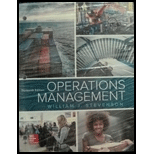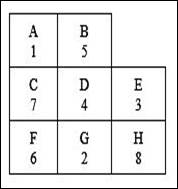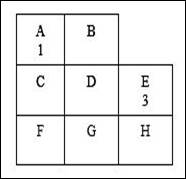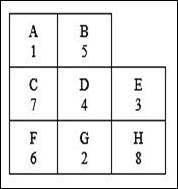
To determine: The new placement of departments that will minimize the total transportation costs.
Introduction:
Product layouts:
Product layout is a production system where the equipment and workstations are placed along the production and assembly lines. A conveyor is used to move the production units along the line. Product layouts have specialized labor to perform specific functions with the help of equipment (programmed to do a specific tasks in a repetitive manner). The layout is mostly based on the processing sequence.
Process layouts:
Process layout is a production system where the equipment is placed in a system based on their functions. The production line is planned to eliminate wastes. In certain process layouts, the machineries and work settings are not arranged as per the standardized production sequence. However, there would be an assembly having similar machineries and operational activities depending on the requirement. For example, paint department.
Answer to Problem 15P
Arrangement:

The total transportation cost for the arrangement is $143, 650 per day.
Explanation of Solution
Given information:
- Work centers 1 and 3 are assigned in two locations and cannot be moved.
- There are 8 work centers.
- Cost is $1 per load per meter.
- The departments are 1, 2, 3, 4, 5, 6, 7, and 8.
- The locations are A, B, C, D, E, F, G, and H.
Distances between locations (meters):
| To | A | B | C | D | E | F | G | H |
| From | ||||||||
| A | 40 | 40 | 60 | 120 | 80 | 100 | 110 | |
| B | 60 | 40 | 60 | 140 | 120 | 130 | ||
| C | 45 | 85 | 40 | 70 | 90 | |||
| D | 40 | 50 | 40 | 45 | ||||
| E | 90 | 50 | 40 | |||||
| F | 40 | 60 | ||||||
| G | 40 | |||||||
| H |
Number of load per day between departments:
| To | 1 | 2 | 3 | 4 | 5 | 6 | 7 | 8 |
| From | ||||||||
| 1 | 10 | 5 | 90 | 370 | 135 | 125 | 0 | |
| 2 | 360 | 120 | 40 | 115 | 45 | 120 | ||
| 3 | 350 | 110 | 40 | 20 | 190 | |||
| 4 | 190 | 70 | 50 | 200 | ||||
| 5 | 10 | 40 | 10 | |||||
| 6 | 50 | 20 | ||||||
| 7 | 20 | |||||||
| 8 |
Locations:

Arrangement of departments:
The numbers of trips between work centers is shown and are ranked from high to low.
| Work centers pair | Number of loads | Ranking |
| 1–2 | 10 | |
| 1–3 | 5 | |
| 1–4 | 90 | 11 |
| 1–5 | 370 | 1 |
| 1–6 | 135 | 6 |
| 1–7 | 125 | 7 |
| 1–8 | 0 | |
| 2–3 | 360 | 2 |
| 2–4 | 120 | 8 (Tied) |
| 2–5 | 40 | |
| 2–6 | 115 | 9 |
| 2–7 | 45 | |
| 2–8 | 120 | 8 (Tied) |
| 3–4 | 350 | 3 |
| 3–5 | 110 | 10 |
| 3–6 | 40 | |
| 3–7 | 20 | |
| 3–8 | 200 | 4 |
| 4–5 | 190 | 5 (Tied) |
| 4–6 | 70 | 12 |
| 4–7 | 50 | |
| 4–8 | 190 | 5 (Tied) |
| 5–6 | 10 | |
| 5–7 | 40 | |
| 5–8 | 10 | |
| 6–7 | 50 | |
| 6–8 | 20 | |
| 7–8 | 20 |
The table clearly indicates that work centers 1-5 have the highest number of trips between them. After that the following work centers have the most number of trips: 2-3, 3-4, 3-8, 4-5, 4-8, 1-6, 1-7, 2-4, 2-8 and others. After continuous trial and error method the following assignment is reached. It is to be noted that, except the pre assigned work centers, slight variations are reasonable in the assignment as long as work centers 2,4 and 8 are nearer to 3, 4 is nearer to 5 and 5 is nearer to 1.

Calculation of cost for each work center pair:
The cost for each department pair is calculated by multiplying the number of loads with the distance with the cost per load per meter.
Department 1-2:
Department 1-3:
Department 1-4:
Department 1-5:
Department 1-6:
Department 1-7:
Department 2-3:
Department 2-4:
Department 2-5:
Department 2-6:
Department 2-7:
Department 2-8:
Department 3-4:
Department 3-5:
Department 3-6:
Department 3-7:
Department 3-8:
Department 4-5:
Department 4-6:
Department 4-7:
Department 4-8:
Department 5-6:
Department 5-7:
Department 5-8:
Department 6-7:
Department 6-8:
Department 7-8:
Calculation of total cost:
The total cost is calculated by adding the cost of individual work center pairs.
The total transportation cost for the arrangement is $143,650.
Want to see more full solutions like this?
Chapter 6 Solutions
OPERATIONS MANAGEMENT (LL) >CUSTOM<
- Having low variability and high demand is a major assumption for justifying which of the following layout types? A. fixed-position layout B. warehouse layout C. process-oriented layout D. product-oriented layoutarrow_forwardContrast and compare the plant layout procedures proposed by Logic, Correlap, and ALDEParrow_forwardUsing the precedence diagram on page 2 of this document, we have created four layouts below. Which of these four layouts is NOT valid? The Answer is D but I don't understand why :( Can someone explain the precedence rule and how it works here? tysmmarrow_forward
- Consider the relationship chart for the a fast-food restaurant, Assume that the areas required for each department are: Department Area Required (Square feet) (CB) 300 (CF) 200 (PS) 200 (DD) 200 (CS) 300 Assume facility dimension of 6 (horizontal) by 8 (vertical) squares, where each square is 5 feet on a side. As a result, for example the CB department requires 12 squares. Develop a layout for the fast-food restaurant.arrow_forwardSix departments, A, B, C, D, E, and F, consume respectively 12, 6, 9, 18, 22, and 6 squares. Based on a sweep width of 4 and a facility size of 5 by 16, use the techniques employed by ALDEP to find a layout. Assume that the departments are placed in alphabetical order.arrow_forwardTen labs will be assigned to the circular layout shown. Recalling a similar layout’s congestion in the halls, the new lab manager has requested an assignment that will minimize traffic between offices. Department 1 must be at location A. Develop a suitable layout using the following information?arrow_forward
- In which of the following layout type, materials are fed into the first machine and finished products come out of the last machine?(a) Product layout(b) Process layout(c) Fixed position layout(d) Cellular manufacturing layoutarrow_forwardA large-scale company is planning to install a factory to produce airplanes. As the operations manager, you are responsible for layout planning. Which type of layout is most preferable for your business? Please explain why.arrow_forwardGive an example of a poor layout. Find a better solutionfor that layout problem.arrow_forward
- Layout planning involves decisions about the physical arrangement of economic activity centres within a facility. With reference to the organization of your choice discuss the advantages and disadvantages of the particular layouts that are employed and evaluate why these layouts are appropriate?arrow_forwardProcess Layout Determine the placement of departments for a newly designed layout facility that will minimize the total material handling costs using the data in the following table 1 and table 2. Assume that reverse distances are the same. The current layouts are shown in the grid below. Use a cost of RM1 per trip. Current Layout. Departments A (Room 1) Departments B (Room 2) Departments C (Room 3) Departments D (Room 4) Table 1 To From Distance between rooms (meters) 1 2 3 4 1 - 40 80 70 2 - 40 50 3 - 60 4 - Table 2 To From Loads between departments A B C D A - 10 20 80 B - 40 90 C - 55 D - You are required to: Analyze current “load x distance” of the current layout shown and compute its movement costs. Propose a new layout and compute its movement cost.arrow_forwardOption D is incorrect! please help Because the nature of a fixed-position layout often means there is no single facility to house all processes on a permanent basis, this layout is often more closely associated with _______ than with _______ A. matrix organizational structures; functional organizational structures B. functional organizational structures; matrix organizational structures C. sustained production; project management D. project management; sustained productionarrow_forward
 Practical Management ScienceOperations ManagementISBN:9781337406659Author:WINSTON, Wayne L.Publisher:Cengage,
Practical Management ScienceOperations ManagementISBN:9781337406659Author:WINSTON, Wayne L.Publisher:Cengage, Operations ManagementOperations ManagementISBN:9781259667473Author:William J StevensonPublisher:McGraw-Hill Education
Operations ManagementOperations ManagementISBN:9781259667473Author:William J StevensonPublisher:McGraw-Hill Education Operations and Supply Chain Management (Mcgraw-hi...Operations ManagementISBN:9781259666100Author:F. Robert Jacobs, Richard B ChasePublisher:McGraw-Hill Education
Operations and Supply Chain Management (Mcgraw-hi...Operations ManagementISBN:9781259666100Author:F. Robert Jacobs, Richard B ChasePublisher:McGraw-Hill Education
 Purchasing and Supply Chain ManagementOperations ManagementISBN:9781285869681Author:Robert M. Monczka, Robert B. Handfield, Larry C. Giunipero, James L. PattersonPublisher:Cengage Learning
Purchasing and Supply Chain ManagementOperations ManagementISBN:9781285869681Author:Robert M. Monczka, Robert B. Handfield, Larry C. Giunipero, James L. PattersonPublisher:Cengage Learning Production and Operations Analysis, Seventh Editi...Operations ManagementISBN:9781478623069Author:Steven Nahmias, Tava Lennon OlsenPublisher:Waveland Press, Inc.
Production and Operations Analysis, Seventh Editi...Operations ManagementISBN:9781478623069Author:Steven Nahmias, Tava Lennon OlsenPublisher:Waveland Press, Inc.





